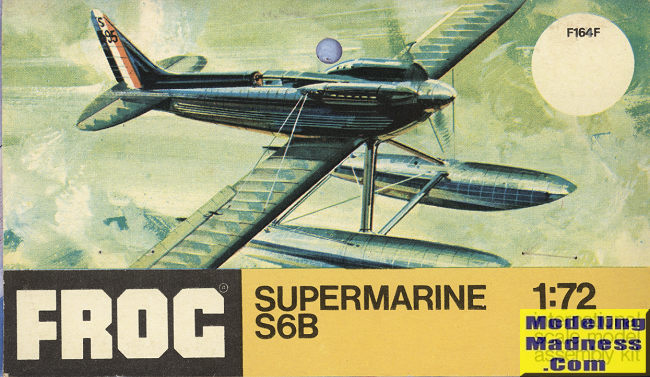
| KIT #: | F-164 |
| PRICE: | Free from a friend |
| DECALS: | One option |
| REVIEWER: | Scott Van Aken |
| NOTES: | Kit has been started. |

| HISTORY |
The Supermarine S.6B is a British racing seaplane developed by R.J. Mitchell for the Supermarine company to take part in the Schneider Trophy competition of 1931. The S.6B marked the culmination of Mitchell's quest to "perfect the design of the racing seaplane" and represented the cutting edge of aerodynamic technology for the era.
The S.6B was last in a line of racing seaplanes to be developed by Supermarine, followed on from the S.4, S.5 and the S.6. Despite these predecessors having twice won the Schneider Trophy previously, the development of the S.6B was troubled by wavering government support, being promised, withdrawn, and then issued once again following a high-profile public campaign encouraged by Lord Rothermere and a substantial donation by Lady Houston. Once government backing had been secured, there were only nine months remaining until the race, thus Mitchell decided to refine the existing S.6 rather than pursue a clean-sheet design, thus the type's designation of S.6B.
The principal design differences between the S.6 and the S.6B were made in its more powerful Rolls-Royce R engine and redesigned floats, providing much needed additional cooling; minor aerodynamic refinements typically aimed at drag reduction were also implemented. A pair of S.6Bs, serials S1595 and S1596, were constructed for the competition. Flown by members of RAF High Speed Flight, the type competed successfully, winning the Schneider Trophy for Britain. Shortly after the race, S.6B S1596, flown by Flt Lt. George Stainforth, broke the world air speed record, attaining a peak speed of 407.5 mph (655.67 km/h).
Supermarine did not build any successive racing aircraft during this era, largely due to other commitments, including the development of a new fighter aircraft at the request of the British Air Ministry, known as the Type 224. Mitchell and his team's experience in designing high speed Schneider Trophy floatplanes greatly contributing to the development of the later Supermarine Spitfire, an iconic fighter aircraft flown in large numbers by the Royal Air Force; it has been viewed as Britain's most successful interceptor of the Second World War. Both the Spitfire and its Rolls-Royce Merlin engine drew directly upon the S.6B and its Rolls-Royce R engine respectively.
| THE KIT |
 This
kit was given to me by a friend. It had been started in that the fuselage
halves were cemented together, as were the wing halves and the floats. Some
of the float struts were glued in as well. The kit is one of Frog's header
card offerings from about 1969. It was originally released in 1964 as one of
their Trailblazers offerings.
This
kit was given to me by a friend. It had been started in that the fuselage
halves were cemented together, as were the wing halves and the floats. Some
of the float struts were glued in as well. The kit is one of Frog's header
card offerings from about 1969. It was originally released in 1964 as one of
their Trailblazers offerings.
The kit has no interior and the prop is trapped between the fuselage halves and an upper cowling piece. There is a hole in the bottom of the fuselage for a stand, but I doubt that was part of the header card kit. Floats have two very positive fitting upper struts per side and to keep things aligned, there are cross braces.
Wings and tailplanes are upper and lower halves. The kit provides separate flight control surfaces, something that Frog has done since its early days of plastic kits. Instructions are on the back of the header card and a small decal sheet has the minimal markings of the aircraft, which are rudder stripes and the racing #1. The airplane is silver and pre-war roundel blue, a much lighter shade than that used in WWII.
| CONCLUSIONS |
Over 40 years ago, I built the Airfix version of this aircraft, but never the Frog variant. Hawk did this in 1/48 and I'm sure others have kitted this as well. This is a very basic kit and should prove suitable for beginners. Even old timers will have a nice time building (along with filling and sanding) this one.
| REFERENCES |
https://en.wikipedia.org/wiki/Supermarine_S.6B
October 2020
Copyright ModelingMadness.com. All rights reserved. Thanks to
Bill Wagner
for the review kit. If you would like your product reviewed fairly and fairly quickly, please
contact
the editor or see other details in the
Note to
Contributors. Back to the Main Page
Back to the Review
Index Page
Back to the Previews Index Page